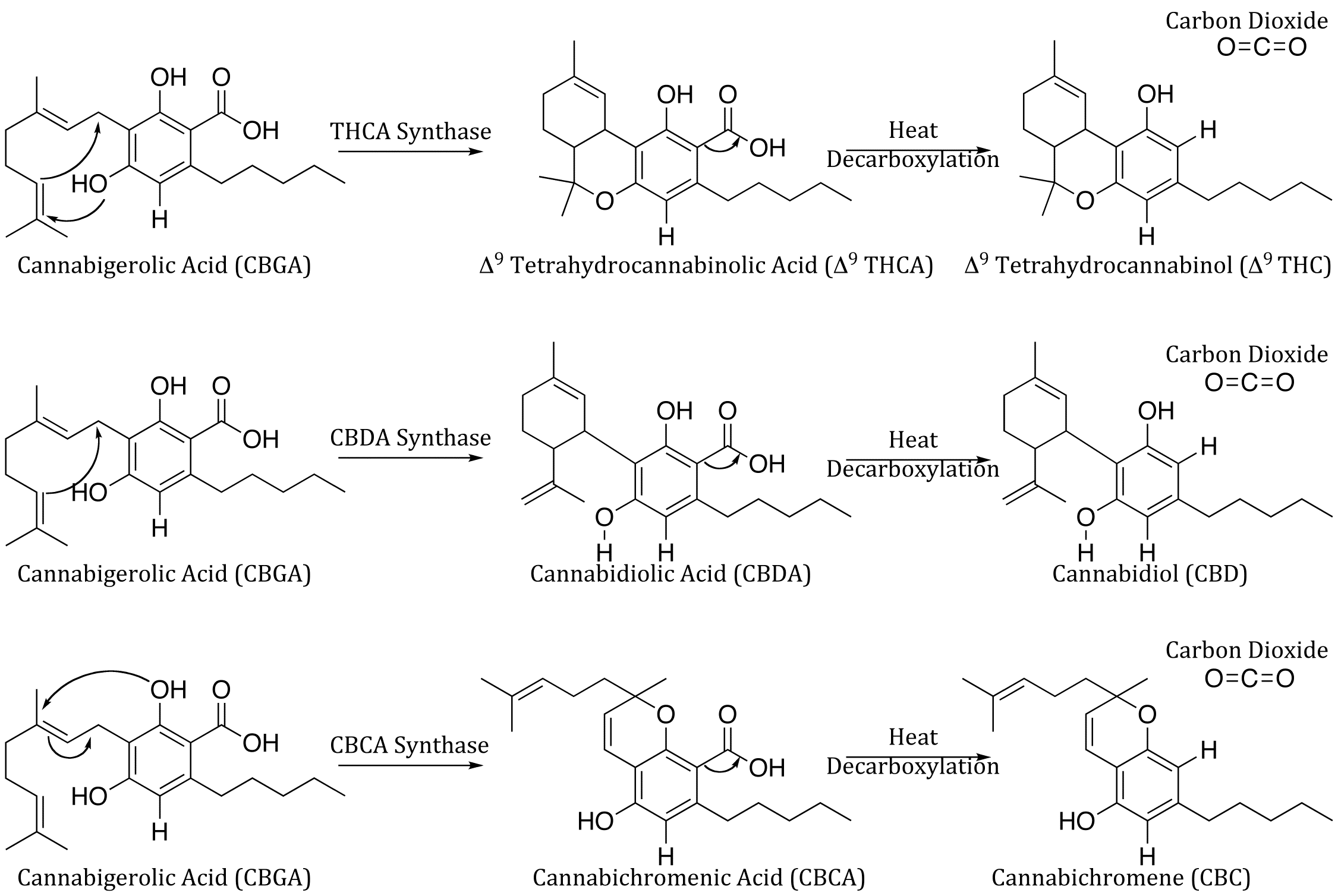Nicolas Burns examines Cannabichromene (CBC)’s therapeutic effects and the chemistry behind it.

The following is an article produced by a contributing author. Growers Network does not endorse nor evaluate the claims of our contributors, nor do they influence our editorial process. We thank our contributors for their time and effort so we can continue our exclusive Growers Spotlight service.
What is Cannabichromene? It is one of 119 different identified cannabinoids that are found in the cannabis plant, and is abbreviated as CBC. But that doesn’t mean much to us, so let’s explore its relevance, both in terms of its pharmacology and its chemistry.

Pharmacology
Like most cannabinoids, Cannabichromene can be used in therapeutic settings and beyond. CBC has been shown to have potential as an analgesic or pain reliever. When ingested, it stimulates the descending antinociceptive pathways and several proteins related to nociceptive control.[7] The nociceptive pathway is a 3-neuron chain that recognizes the pain and informs the brain where the pain is located. Abnormalities in nociceptive pathways can lead to pathological pain (chronic pain). This means that CBC could lend itself in the treatment of pathological pain disorders.[8] Given these results the compound seems promising but it must be thoroughly evaluated.

CBC’s potential role in therapy extends further, as it has been shown to be a possible anti-inflammatory. A study found CBC was just as effective an inflammatory as phenylbutazone (PBZ), but without the toxic side effects. The toxicity of PBZ has resulted in its discontinuation in the US. The authors of the study stated that, given equivalent doses, CBC’s lower toxicity opens up the potential for usage in larger doses.[5] In a separate study, CBC was also shown to reduce gastrointestinal inflammation in specific cases. And, unlike opioids, CBC does not cause constipation.[6]
Furthermore, CBC seems to possess some antimicrobial qualities, described in the literature as “potent” against microbes. The antimicrobial properties were not limited to just common microbes, but also displayed high efficacy against some multidrug resistant strains of S. aureus (MRSA). The mechanism of action is completely different from current antibiotic agents, which may prove useful in treatments down the road. The molecular makeup of the compound could also make it cheap and biodegradable.[9]
Finally the cannabinoid has been shown to be promising as an antidepressant. While THC has shown effectiveness at approximately 2.5mg per kg of body weight, CBC is right behind it at 40-80mg per kg of body weight. The authors of the study stated that, “the non-psychotropic CBC elicited a significant dose-dependant reduction in immobility indicative of antidepressant-like action.”[10] In common parlance, that means that CBC did not have the psychoactive effects of THC, but showed potential as an antidepressant.
Chemistry/Biosynthesis
Cannabichromene (CBC) is the decarboxylated form of Cannabichromene carboxylic acid (CBCA) and one of three major cannabinoids. It is derived from Cannabigerolic Acid (CBGA), which also serves as the precursor to many cannabinoids, including THC, CBD, and CBC.[1]

The enzyme CBCA synthase catalyzes a reaction between CBGA and Cannabinerolic acid.[2] The ratio that these compounds are found in cannabis is determined by the ratio of enzymes and the activity of their respective genes.
Because cannabis is legally considered a Schedule 1 substance, research into the plant’s genome is highly restricted and has been severely delayed.[3] It wasn’t until very recently that a genomic map had been produced for cannabis. More research is necessary to locate the elusive CBCAS or CBCA synthase gene so that direct modification or artificial selection for CBC can occur.
Call to Action
If you are interested in seeing how CBC affects yourself, strains that are typically high in CBC include:
- 3 Kings
- Jorge’s Diamonds #1
- Bediol
- Landrace strains from India.
Also, please let us know what other cannabinoids might interest you. Contact hunter@growersnetwork.org to suggest other cannabinoids.
References
- Hanuš, L. O., Meyer, S. M., Muñoz, E., Taglialatela-Scafati, O., & Appendino, G. (2016). Phytocannabinoids: a unified critical inventory. Natural product reports, 33(12), 1357-1392.
- Morimoto, S., Komatsu, K., Taura, F., & Shoyama, Y. (1998). Purification and characterization of cannabichromenic acid synthase from Cannabis sativa. Phytochemistry, 49(6), 1525-1529.
- https://www.dea.gov/factsheets/marijuana
- Lu, H. C., & Mackie, K. (2016). An introduction to the endogenous cannabinoid system. Biological psychiatry, 79(7), 516-525.
- Wirth, P. W., Watson, E. S., ElSohly, M., Turner, C. E., & Murphy, J. C. (1980). Anti-inflammatory properties of cannabichromene. Life sciences, 26(23), 1991-1995.
- Izzo, A. A., Capasso, R., Aviello, G., Borrelli, F., Romano, B., Piscitelli, F., ... & Di Marzo, V. (2012). Inhibitory effect of cannabichromene, a major non‐psychotropic cannabinoid extracted from Cannabis sativa, on inflammation‐induced hypermotility in mice. British journal of pharmacology, 166(4), 1444-1460.
- Maione, S., Piscitelli, F., Gatta, L., Vita, D., De Petrocellis, L., Palazzo, E., ... & Di Marzo, V. (2011). Non‐psychoactive cannabinoids modulate the descending pathway of antinociception in anaesthetized rats through several mechanisms of action. British journal of pharmacology, 162(3), 584-596.
- Lemke, K. A. (2004). Understanding the pathophysiology of perioperative pain. The Canadian Veterinary Journal, 45(5), 405.
- Appendino, G., Gibbons, S., Giana, A., Pagani, A., Grassi, G., Stavri, M., ... & Rahman, M. M. (2008). Antibacterial cannabinoids from Cannabis sativa: a structure− activity study. Journal of natural products, 71(8), 1427-1430.
- El-Alfy, A. T., Ivey, K., Robinson, K., Ahmed, S., Radwan, M., Slade, D., ... & Ross, S. (2010). Antidepressant-like effect of Δ9-tetrahydrocannabinol and other cannabinoids isolated from Cannabis sativa L. Pharmacology Biochemistry and Behavior, 95(4), 434-442.
10 Best Gift Ideas for Cannabis Connoisseurs and Growing Aficionados (2022)
December 7, 2022Developing and Optimizing a Cannabis Cultivation System
December 14, 2021Dealing with Insomnia: How Can CBD Help?
December 10, 2020Your Guide to Sleep and CBD
December 7, 2020
Do you want to receive the next Grower's Spotlight as soon as it's available? Sign up below!
Resources:
Want to get in touch with Nicolas Burns? He can be reached via the following methods:
- LinkedIn: https://www.linkedin.com/in/nicolas-burns-a5368312a/
- Email: ndb1776@rit.edu

Do you have any questions or comments?
